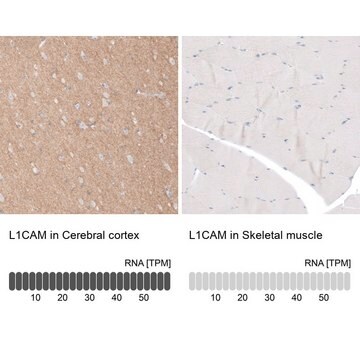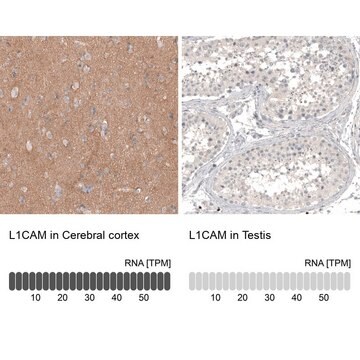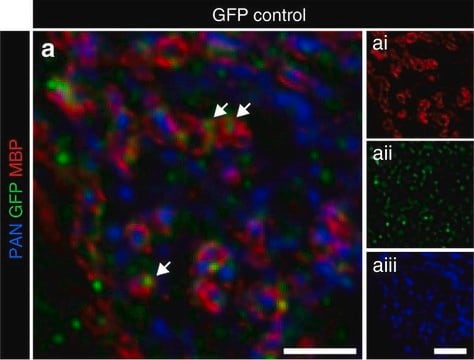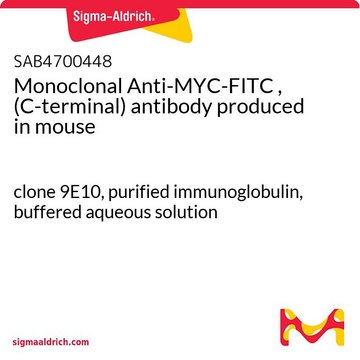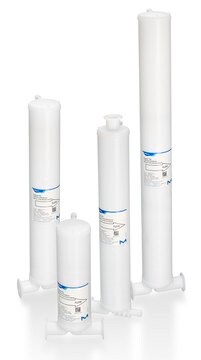MABN2299
Anti-L1CAM/CD171 Antibody, clone S10.33
Synonim(y):
CD171, Cząsteczka adhezji komórek nerwowych L1, N-CAM-L1, NCAM-L1
About This Item
Polecane produkty
pochodzenie biologiczne
rat
Poziom jakości
forma przeciwciała
purified antibody
rodzaj przeciwciała
primary antibodies
klon
S10.33, monoclonal
reaktywność gatunkowa
mouse
opakowanie
antibody small pack of 100
metody
flow cytometry: suitable
immunocytochemistry: suitable
immunofluorescence: suitable
immunohistochemistry (formalin-fixed, paraffin-embedded sections): suitable
izotyp
IgG2aκ
sekwencja epitopowa
Extracellular domain
numer dostępu UniProt
informacje o genach
mouse ... L1cam(16728)
Specyficzność
Immunogen
Zastosowanie
Ocena immunocytochemiczna w komórkach Neuro2A.
Analiza immunocytochemiczna: Rozcieńczenie 1:100 tego przeciwciała wykryło L1CAM/CD171 w komórkach Neuro2A.
Testowane aplikacje
Analiza cytometrii przepływowej: Reprezentatywna partia wykryła L1CAM/CD171 w zastosowaniach cytometrii przepływowej (Maddaluno, L., et al. (2009). J Exp Med. 206(3):623-35).
Zastosowania immunohistochemiczne: Reprezentatywna partia wykryła L1CAM/CD171 w zastosowaniach immunohistochemicznych (Maddaluno, L., et al. (2009). J Exp Med. 206(3):623-35).
Analiza immunofluorescencyjna: Reprezentatywna partia wykryła L1CAM/CD171 w zastosowaniach immunofluorescencji (Maddaluno, L., et al. (2009). J Exp Med. 206(3):623-35; Magrini, E., et al. (2014). J Clin Invest. 124(10):4335-50).
Uwaga: Rzeczywiste optymalne rozcieńczenia robocze muszą być określone przez użytkownika końcowego jako próbki, a warunki eksperymentalne mogą się różnić w zależności od użytkownika końcowego.
Opis wartości docelowych
Postać fizyczna
Rekonstytucja
Przechowywanie i stabilność
Inne uwagi
Oświadczenie o zrzeczeniu się odpowiedzialności
Nie możesz znaleźć właściwego produktu?
Wypróbuj nasz Narzędzie selektora produktów.
Kod klasy składowania
12 - Non Combustible Liquids
Klasa zagrożenia wodnego (WGK)
WGK 1
Temperatura zapłonu (°F)
Not applicable
Temperatura zapłonu (°C)
Not applicable
Certyfikaty analizy (CoA)
Poszukaj Certyfikaty analizy (CoA), wpisując numer partii/serii produktów. Numery serii i partii można znaleźć na etykiecie produktu po słowach „seria” lub „partia”.
Masz już ten produkt?
Dokumenty związane z niedawno zakupionymi produktami zostały zamieszczone w Bibliotece dokumentów.
Nasz zespół naukowców ma doświadczenie we wszystkich obszarach badań, w tym w naukach przyrodniczych, materiałoznawstwie, syntezie chemicznej, chromatografii, analityce i wielu innych dziedzinach.
Skontaktuj się z zespołem ds. pomocy technicznej


